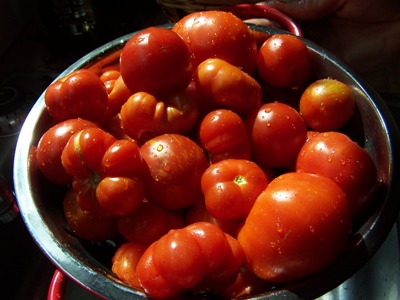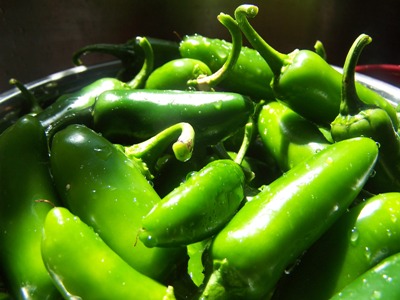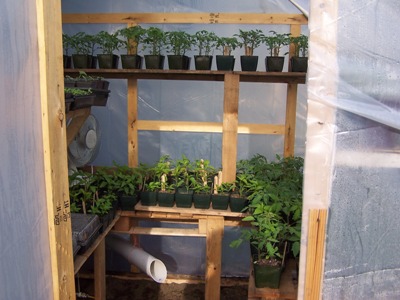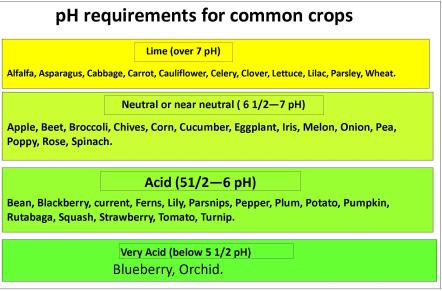Gardening
From harborpedia
Gardening is the practice of growing plants. Geographical area has a large impact on gardening practice. West of the Cascade mountain range is a maritime climate; springs are short, falls are long, and summers are not extended hot[4]. The Grays Harbor area has a climate with a steady, moist, and mild weather pattern. The Pacific Ocean causes solar warmth which is slowly accumulated and slowly released, creating moderate temperatures. And, the winds from the ocean bring cool and moist air. [5]
Contents |
Gardening in western Washington
The Master Grardener Foundation of Grays Harbor and Pacific Counties Washington, an extension of Washington University Master Gardeners, has tips, resources, and events for Grays Harbor Gardeners. The web site to this is: http://pnwmg.org/index.html[1]
Gray’s Harbor is a northern climate and a planting zone 9. Planting zones are determined by temperatures and length of growing season. Zone 9 means that there is an average low temperature of 20-30 degrees Fahrenheit. [2] Cold growing seasons are the largest challenge for northern climate gardeners. A cool growing season can make it difficult for some vegetables and fruits to ripen completely. Rather then lack of sun, it is the cool northern air currents which create this problem - but that should not negate the importance of sunlight in the north. [2]
Even with the short growing season, the possibilities are endlessly beautiful…


Location of the garden can make a difference. See below:
A: frost pocket collects cold air sliding down hill B: sheltered area protected by trees from settling cold air C: Frost pocket created by trees D: well-drained area sloping toward sun E: cold, windy hilltop F: northwester slop exposed to cold winds and little sunlight A sunny well-drained location for your garden is essential; south or south east facing land is ideal. [2]
Selecting a variety of plant that is intended for northern climate will help ensure successful gardening. Also, northern gardeners lengthen the shorts growing season by starting seeds by artificial light in a green house or in the house, and by using hot caps, plastic tents, and other shelters outdoors to keep late spring and early fall frost of the plants. Plants need light, heat, fertilizer, and moister to germinate and grow. [2]
Suggested seed starting schedule (too transplant into garden in early June). January: Begonias, Double Petunias. February: Celery, Pansies, Marigolds, Geraniums. March: Eggplant, Herbs, Peppers, Tomatoes, Snapdragons, Daisies. April: Broccoli, Brussels sprouts, Cabbage, Cauliflower, Lettuce, Melons, Pumpkins, Squash. [2]
Coldframes and Greenhouses
Ways to garden through the short season, you'd be amazed what a difference it can make!
Cold frames are very simple structures frequently made with whatever spare materials are available. They are shallow boxes or frames designed to keep the cold away from the plates. Wood, concrete, plastic, and glass materials can be used; any thing to surround the plants on all sides and with a removable or opening top. Using cold frames allows the gardener to plant outside before the dangers of hard frost have completely left the garden. A hot bed is a cold frame with some form of heat on the bottom. Soil cables area common form of heating used.
- it is important to remember that cold frames, hot beds and green houses need to be attended, so that on hot afternoons the plants do not overheat in the these smaller spaces.[2]
Green houses come in many varieties; from plastic lined frames, to permanent temperature controlled structures. The aim of a green house is to maximize sunlight and warmth, so in northern climates green houses are most successful when fully exposed and glass-to-ground structures [6].
Ventilation is an important aspect to greenhouses as both humidity and temperature are affected by air flow. Plants need fresh air to replenish their supplies of carbon dioxide and oxygen – less is needed in the colder months. Vents should be positioned away from wind to avoid drafts in the greenhouse [6].
Fans should be used to provide residence to the growing plants, encouraging hardiness and strong stocks [6].
pH levels in the garden
If the soil is too acidic or too alkaline the plants will be unable to absorb nutrients. The letters pH are commonly referred to as potential hydrogen. The pH or acid-alkalinity of soil is caused by the breakdown of some of the hydrogen atoms of the water in the soil, into positive and negative ions. The mineral and organic matter of the soil affects the breakdown. The chemical pH scale ranges from 1 to 14. 1 being the most acid, and14 being the most alkaline. Seven is neutral. Most vegetables grow best in soil with a pH of 6-7, as do most berries and fruits. Northern soils tend to be acidic. Using plenty of mulch, compost, wood ashes, and manures in the garden will prevent pH off-balance. [2]
Northwest soils:
Almost all of the soils west of the Cascades have several components in common. They are generally rich in potassium, and lacking in phosphorus and nitrogen. The Grays Harbor region is unique as it is more likely to have potassium depletion due to the amount of rain in the area; most coastal regions in Washington experience this. [4]
Nitrogen shortages in the soil will add with other factors making growing the following vegetables more difficult: legumes, including beans, peas, and clovers. [4]
A gram of healthy soil has up too 500 million organisms in it, including: “bacteria, actinomycetes, fungi, yeasts, protozoa, algae, etc.” [5]. These organisms are what create the abundance and balance of nutrients in the soil, so it is the gardeners role to protect and assist this balance through composting, planting cover crops, adding mulch and fertilizers, and paying attention to the sun, air, and water contents. [5]
Raised beds
Creating raised beds in northern climates is common for vegetable growing. Raised beds are a few inches off of the surrounding area, and help the garden bed drain better, warm up faster, and keep heat. Raised beds range from the very simple to very elaborate, examples are: piling 6 inches or more of soil, using tires, using wide boards to enclose the garden bed, and building garden boxes with rock and wire mess bottoms (for drainage). [2]
Compost
Compost is the core, the essential foundation of natural gardening and farming. There are two basic things about composting: there must be organic materials and proper conditions to decompose them.
With proper organic matter in the soil there will be:
1) More extensive plant root systems
2) More water entering the soil faster
3) Less water leaving the soil, and therefore less erosion and greater water storage for the plants
4) Greater aeration
5) Less soil baking and less crust formation
[7]
Watering
Because the northern areas have such a short growing season, it is very important that plants receive sufficient water during critical growing days in June and early July. Watering should be done in early morning, when there is less sun and wind to evaporate the moisture before the plants can soak it in through their root system. The soil should be soaked every time you water; light sprinkling only encourages shallow roots. Two good watering twice a week is better then daily light watering. [2]
Vegetables
Vegetables need rich soil, water, and light. With these three ingredients they will produce the nutrient rich foods that we consume daily. [4]
Two benefits from growing your vegetables at home are: 1) you’ll eat more vegetables and thus gain the health benefits of a diet rich with nutrients, minerals, and fiber, and 2) you’ll save money on groceries. [1]
Rotation
Rotation of your garden planting areas is important and easy. The basic rule for rotation is that you do not plant vegetables from the same family in the same garden plots year after year. Think of it this way, each vegetable family has similar nutrient needs, if planted in the same area every year, the soil will be depleted of these nutrients. By rotating your crops you will sustain balanced soil, and gain better crops from the healthy plants. Also, garden insects will be less likely to devour your garden if they can not set up generations in the same spot, happily eating away. [4]
Many garden pest have a specific plant host which they need, so have no doubt that they will remember where those plants are and come back form them .[5]
Community Gardens
Author Mary Lee Coe wrote the book Growing with Community Gardening, a book focused on how communities can organize and structure community gardening in their area. Two point emphasized in her book when beginning a community garden are too: Find a sponsor. Consider applying to a local park or recreational department. This has become increasing common because community gardening is a lower cost family recreation option. Other areas to approach are churches, private organizations, clubs, and citizen group. And, too create a formal land use commitment once you find a location for the garden. This is a simple written lease provided by the owner of the property. The city planning department, the outdoor recreation department, or the local tax assessor is good resources for information on this. [3]
Recommended Reading
The reference section is also a good place to go for recommend reading.
• How to grow frits and vegetables by Organic method by J.I. Rodale
• Vegetable Gardening Know-How by Dick Raymond
• Companion Plants and How to Use Them by Helen Philbrick and Richard Gregg
References
1) Blaylock, James R. and Anthony E. Gallo. Modeling the Decision to Produce Vegetables at Home. American Journal of Agricultural Economics, Vol. 65, No. 4 (Nov., 1983), pp. 722-729.
2) Hill, Lewis. Successful Cold-Climate Gardening. Vermont: The Stephen Greene Press, 1981. Print.
3) Coe, Mary L. Growing with Community Gardening. Vermont: The Countryman Press, 1978. Print.
4) Solomon, Steve. The Complete guide to organic Gardening west of the Cascades. Seattle: Pacific Search Press, 1981. Print
5) Elliott, Carl. The Maritime northwest garden guide: planning calendar for year-round organic gardening. Seattle: Seattle Tilth Association, 1964. Print.
6) Clegg, Peter, and Derry Watkins. Building and Using Greenhouses; From Cold frames to Solar Structures. Vermont: Garden Way Publishing, 1978. Print.
7) Rodale, J.I., Robert Rodale, Jerome Plds, M.C. Goldman, and Maurice Franz. The Complete Book of Composting. N.p.: Rodale Books, 1973. Print.





